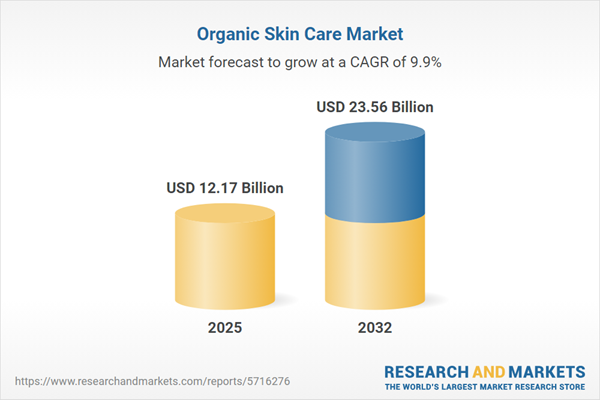Speak directly to the analyst to clarify any post sales queries you may have.
The organic skin care market is undergoing rapid transformation as brands adapt to growing calls for supply chain transparency and emerging regulatory standards. Senior executives are advancing sustainable innovation, fostering resilient networks, and strengthening strategic partnerships to secure market advantage and propel long-term growth.
Market Snapshot: Organic Skin Care Market Growth and Industry Momentum
The global organic skin care market, fueled by increasing demand for clean-label solutions, continues to expand as companies recalibrate business models and procurement strategies. Organizations along the supply chain boost supplier accountability and revise sourcing approaches to reinforce credibility. Market participants focus on flexible, ethical relationships and operational agility to respond to swift innovation cycles and regulatory shifts. These trends influence B2B buyers, who now prioritize ethical sourcing, enhanced traceability, and distinct value differentiation when selecting partners and solutions.
Scope & Segmentation: Organic Skin Care Market Analysis
- Product Types: Includes cleansers, micellar waters, foaming agents, nutrient-rich creams, serums, exfoliators, facial masks, peels, protective oils, and toners. These options address a spectrum of commercial and retail demands.
- Distribution Channels: Digital sales, pharmaceutical outlets, specialty retailers, supermarkets, and hypermarkets enable both efficient online procurement and tailored in-store experiences for decision-makers.
- Price Tiers: Comprises luxury, premium, and mass-market options, supporting brands as they align portfolios to diverse procurement needs and B2B sales strategies.
- Skin Concerns Addressed: Solutions tailored for acne, anti-aging, brightness, hydration, and sensitive skin empower professionals to target wide-ranging consumer and client requirements.
- End User Segments: Products cater to men, women, and gender-neutral groups, supporting inclusive approaches and effective targeting for diverse business requirements.
- Age Groups: Specialized offerings for teens, adults, and seniors help businesses refine procurement and targeting strategies by life stage.
- Certifications: Ranges include COSMOS, Ecocert, and USDA Organic-compliant selections along with non-certified products, supporting differentiated compliance and branding initiatives.
- Packaging Types: Bottles, jars, pumps, and tubes integrate sustainable materials and regulatory alignment throughout the supply chain, reinforcing brand positioning and compliance commitments.
- Regions: Coverage spans the Americas, Europe, Middle East, Africa, and Asia-Pacific. Approaches are tailored to suit regulatory and customer landscapes in major countries, such as the United States, Canada, United Kingdom, Germany, France, Japan, China, India, and Australia.
- Key Industry Players: Industry leaders include L’Oréal S.A., Unilever PLC, The Procter & Gamble Company, Estée Lauder Companies Inc., Shiseido Company, Beiersdorf AG, Amorepacific, Natura & Co, Clarins Group, and Weleda AG, which establish standards for innovation and operational excellence across the ecosystem.
Key Takeaways: Strategic Guidance for Senior Decision-Makers
- Multipurpose formulations with fully traceable ingredients foster trust and equip B2B buyers with durable solutions for evolving business needs.
- Investment in biotechnology and green chemistry drives targeted innovation, resulting in quicker responses to changing regulations and market trends.
- Emphasizing certifications and deeper supply chain traceability demonstrates leadership in ethical sourcing and elevates procurement standards for partners and customers.
- Incorporating artificial intelligence and predictive analytics enhances demand planning, operational efficiency, and collaboration across the supply network.
- Customizing regional strategies, such as advancing traceability in North America and leveraging digital tools in Asia-Pacific, supports alignment with local compliance and helps achieve global consistency.
- Growth in gender-neutral and function-based lines allows for adaptable, portfolio management that aligns with shifting demographic expectations in the B2B segment.
Tariff Impact: Managing Policy Shifts and Supply Chain Complexity
Recent updates to U.S. tariffs on organic skin care ingredients and packaging are causing organizations to reassess procurement expenditures and logistics processes. Companies counter these changes by widening sourcing networks, engaging closely with suppliers, and investing in measures that enhance supply chain resilience. Such strategies help reduce risk and support operational continuity as policy conditions continue to evolve.
Methodology & Data Sources
This analysis combines insights from direct industry interviews, reviews of regulatory and scientific documentation, and integrated quantitative modeling. A robust cross-validation process ensures relevance and accuracy for senior leaders prioritizing effective sourcing and strategic execution.
Why This Report Matters: Strategic Value for B2B Leaders
- Provides executives with concrete guidance for navigating innovation cycles, operational agility, and sustainable positioning in the organic skin care sector.
- Supports portfolio and technology investment decisions through comprehensive segmentation and competitive analysis tailored for B2B channels.
- Clarifies regulatory and digital transformation trends, building resilience and readiness for evolving business and compliance requirements.
Conclusion
Progress in the organic skin care sector depends on advancing innovation, ensuring consistent compliance, and moving swiftly to meet changing industry dynamics. Organizations that prioritize transparency and foster strong, adaptive supply chain partnerships will be best positioned for sustainable success.
Additional Product Information:
- Purchase of this report includes 1 year online access with quarterly updates.
- This report can be updated on request. Please contact our Customer Experience team using the Ask a Question widget on our website.
Table of Contents
3. Executive Summary
4. Market Overview
7. Cumulative Impact of Artificial Intelligence 2025
Companies Mentioned
The companies profiled in this Organic Skin Care market report include:- L’Oréal S.A.
- Unilever PLC
- The Procter & Gamble Company
- Estée Lauder Companies Inc.
- Shiseido Company, Limited
- Beiersdorf Aktiengesellschaft
- Amorepacific Corporation
- Natura & Co Holding S.A.
- Clarins Group S.A.S.
- Weleda Aktiengesellschaft
Table Information
| Report Attribute | Details |
|---|---|
| No. of Pages | 199 |
| Published | October 2025 |
| Forecast Period | 2025 - 2032 |
| Estimated Market Value ( USD | $ 12.17 Billion |
| Forecasted Market Value ( USD | $ 23.56 Billion |
| Compound Annual Growth Rate | 9.9% |
| Regions Covered | Global |
| No. of Companies Mentioned | 11 |









